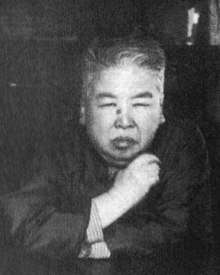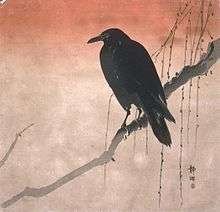Okuhara Seiko
Okuhara Seiko (奥原 晴湖, 1837–1913) Okuhara Seiko was a Literati artist in Japan in the late 1800s. She became a leading artist in Japan founding an art school and displaying her art throughout the country. In 1891, at the age of fifty-five, Seiko decided to retire to a country village. The paintings created by Seiko following her retirement are highly regarded and considered to be some of her finest work.[1]

Biography
Born into the samurai class and renowned for her success as a painter, Seiko resided primarily in Edo-Tokyo, a political and social center of her time. She continued to reside in Edo, where she taught painting and lived in her later years with her companion and student, Watanabe Seiran (1855-1918). Her work is influenced by the Kanō school,[2] but is categorized as within the nanga literati school. Seiko, like most successful Japanese artists of her time, adapted Chinese literati styles to Japanese tastes.[3]

Seiko is notable for her established and well-recognized career during the Meiji period, as well as her reputation within the primarily male literati school. Early in her career, she changed her name from Setsuko to the gender-neutral Seiko. Her work has been characterized as "masculine" in both painting and calligraphy, which may be attributed both to the liberal lifestyle she maintained and the role of women painters at the time. Seiko was also noted for wearing masculine clothing and short hair, deliberately eschewing a feminine persona[4]. As a famous female bunjin (literati artist) artist, she is renowned for earning her own success with her art without literary or artistic connections, much like her contemporary Noguchi Shohin. Both artists also omitted the feminine character ‘joshi’ in their signatures, like many female artists. She and Noguchi Shohin were friends of the statesman Kido Takayoshi and they enjoyed his patronage. Kido and the two of them would create gassaku which are collaborative paintings that include both pictures and text.[5]
Notably, research about female painters in East Asia during the 19th and 20th century is lacking. Historians have suggested that this is not due to a dearth in practicing female artists, which began to be more widely accepted in the 18th century, among the daughters of the gentry.[6] Although women were celebrated as authors and poets, paintings by female artists may have been characterized by Japanese historians as effeminate.[7]
Style
She was a minor pupil of Tani Bunchō, but because of her gender, was not allowed to enter into an apprenticeship. Part of her artistic training involved the copying of funpon (pictorial models), which may be seen in her work and were also later used in her teaching.[8] The use of funpon was derived from the Chinese, as the literati practice followed a Chinese example.[9] Seiko was celebrated for her individual style, which drew from a variety of artistic elements and examples. During Japan at the time, learning through imitation in order to best achieve personal style and expression was reflective of the literati culture.
Works
Although many of her works remain in private hands there is a major collection at the Koga City History Museum with additional pieces held by Tokyo National Museum, the Ibaraki Museum of Modern Art and the Prefectural History Museum, Mito, and the Saitama Prefectural Museum of Modern Art.[4]
References
- "OKUHARA SEIKO, Japanese Artist, 1837-1913, t, Major Female Artist, NO RESERVE | #497797066". Worthpoint. Retrieved 2019-06-06.
- Gordon, Brenda G. (2003). Copying the Master and Stealing His Secrets: Talent and Training in Japanese Painting. University of Hawaii Press. pp. 4, 7, 116–118. ISBN 978-0824826086.
- Addiss, Stephen (Autumn 1993). "Yamanaka Shinten'ō: The Albatross of Japanese Painting". Monumenta Nipponica. 48 (3): 315–336. doi:10.2307/2385129. JSTOR 2385129.
- McClintock, Martha (2003). "Okuhara Seiko". Grove Art Online. Retrieved March 8, 2019.
- Ellen P. Conant (2006). Challenging Past And Present: The Metamorphosis of Nineteenth-Century Japanese Art. University of Hawaii Press. pp. 178–180. ISBN 978-0-8248-2937-7.
- Addiss, Stephen (Autumn 1993). "Yamanaka Shinten'ō: The Albatross of Japanese Painting". Monumenta Nipponica. 48 (3): 315–336. doi:10.2307/2385129. JSTOR 2385129.
- Berry, Paul (Winter 1992). "Flowering in the Shadows: Women in the History of Chinese and Japanese Painting. by Marsha Weidner". Monumenta Nipponica. 47 (4): 561–563. doi:10.2307/2385348. JSTOR 2385348.
- Gordon, Brenda G. (2003). Copying the Master and Stealing His Secrets: Talent and Training in Japanese Painting. University of Hawaii Press. pp. 4, 7, 116–118. ISBN 978-0824826086.
- "Japanese Literati Culture in the Edo Period". www.philamuseum.org. Philadelphia Museum of Art. Retrieved April 10, 2015.